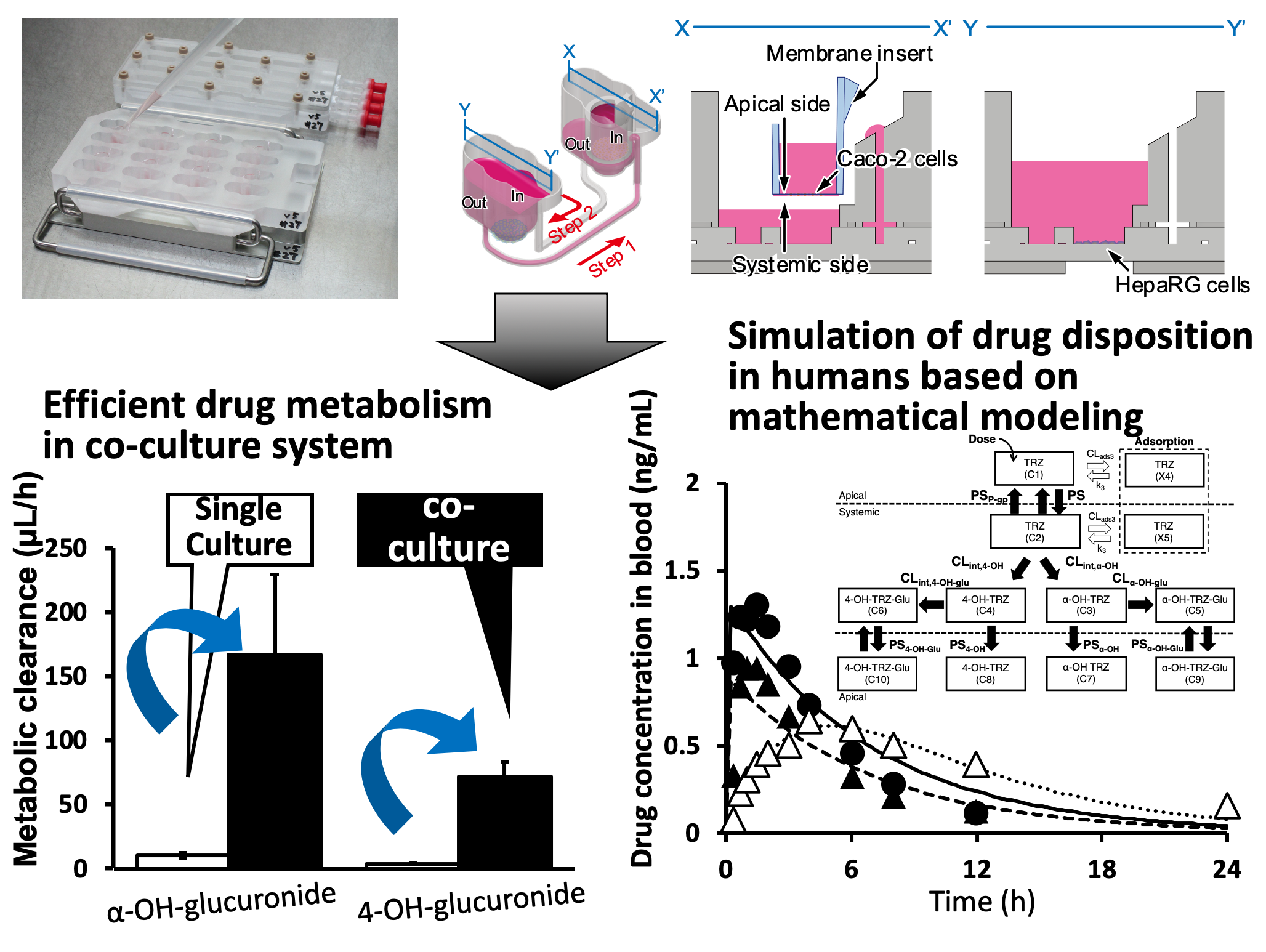Abstract:
Researchers from Kanazawa University have created a two-organ microphysiological system on a microfluidic plate connecting intestinal and hepatic cells, and demonstrated increased metabolism of a model drug triazolam as compared to a single hepatic cell culture. They speculate that this may be due to the dynamic and complex organ-organ interactions that hitherto could not be simulated in conventional in vitro cell culture systems. This promoted precise prediction of drug disposition in humans during drug research and development.
Kanazawa, Japan – Research and development of new drugs requires prediction of their metabolism and disposition in humans prior to clinical trials. Especially, drug metabolism generally exhibits extreme species difference between experimental animals and humans, so precise estimation of drug disposition would be a key factor in successful development of new drugs. Microphysiological systems (MPS) are in vitro culture system composed of single or multiple cells connected with circulation of the medium, and are expected to be used for prediction of drug disposition in humans, although quite limited approach of such quantitative prediction have been available.
Triazolam (TRZ) is a benzodiazepine tranquilizer. Following intestinal absorption, it is metabolized in the liver: phase I involves hydroxylation to α-hydroxy-triazolam and 4-hydroxy-triazolam, and phase II involves glucuronidation of the hydroxy metabolites. While intestinal absorption and hepatic metabolism of TRZ have been studied separately in vitro, and its disposition in humans has been simulated using physiologically based pharmacokinetic models, the complex interactions between intestine and liver have not been considered in such prediction till now.
In a study published in Lab on a Chip in January 2020, researchers from Kanazawa University were able to mimic the interaction between intestinal and hepatic cells in the disposition of TRZ. They created an entero-hepatic MPS consisting of a multiunit microfluidic plate representing Caco-2 intestinal cell cultures and HepaRG hepatic cell cultures linked by pressure-driven microtubules containing circulating culture medium. The configuration was pipette-friendly for convenient sampling, and altering the pneumatic sequence allowed comparison between the two-organ MPS and the single-organ culture.
“Multi-organ MPS research has been focused on designing ‘body-on-a-chip’ systems,” explains Shinji Sugiura, senior author and one of collaborators in the National Institute of Advanced Industrial Science and Technology. “Ours is the first study using the multi-organ MPS for the quantitative evaluation of drug disposition in humans by pharmacokinetic modeling analysis of intestinal absorption and sequential drug metabolism.”
The research team introduced TRZ as a model drug for drug disposition research and measured sequential concentrations of the drug and its metabolites in all chambers by liquid chromatography–mass spectrometry. “The analysis revealed an increased phase II glucuronidation in the two-organ MPS compared to that in the HepaRG single culture,” says Hiroshi Arakawa, lead author. “This may be due to dynamic and complex organ-organ interaction; further advances in MPS-related technology will provide clarification.”
Professor Yukio Kato, corresponding author, explains the potential implications of their results. “We demonstrated organ–organ interaction, which cannot be studied in conventional single-organ culture. In addition, by using the two-organ MPS and pharmacokinetic model, we also quantitatively extrapolated the plasma concentration profile of TRZ and its metabolites in humans. Simulating such interaction will open new research avenues in analyzing sequential metabolism and predicting disposition of candidate drugs in humans.”

Figure 1.Simulation of drug disposition in humans using microphysiological system
Drug was applied to microphysiological system (MPS) which consisted of intestine and liver cells connected with medium circulation. Absorption and metabolism of the drug in the MPS was then chased (upper panels). Kinetic analysis of drug disposition in the MPS revealed higher drug metabolism observed in co-culture system compared to single culture, suggesting interaction of intestinal and hepatic cells. Drug disposition in human bodies can also be simulated based on such kinetic analysis in combination with mathematical model (lower panels).
Article
Kinetic analysis of sequential metabolism of triazolam and its extrapolation to humans using an entero-hepatic two-organ microphysiological system
Journal: Lab on a Chip
Authors:Hiroshi Arakawa, Shinji Sugiura, Takumi Kawanishi, Kazumi Shin, Hiroko Toyoda, Taku Satoh, Yasuyuki Sakai, Toshiyuki Kanamori & Yukio Kato
DOI: 10.1039/c9lc00884e
Funder
This study was partially supported by Japan Agency for Medical Research and Development (A Project Focused on Developing Key Evaluation Technology Aiming at Industrialization of Regenerative Medicine and Gene Therapies)



 PAGE TOP
PAGE TOP